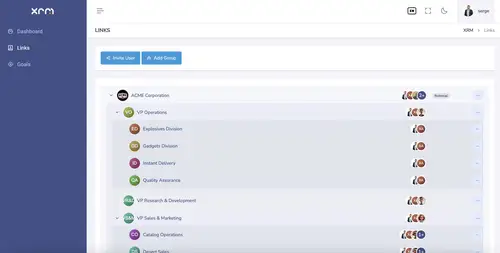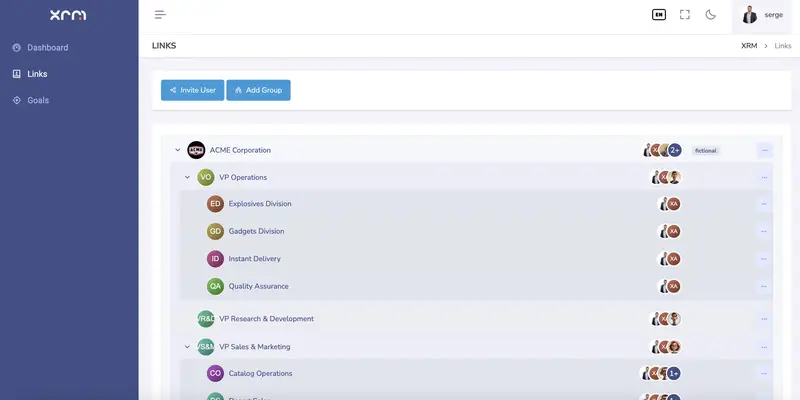OKR Software to Lead Teams to Success
XRM empowers leaders to set crystal-clear OKRs and coordinate high-performing teams that deliver results


XRM Advantages for OKRs
Simple
Kept simple
Prioritized
Important first
Goal tree
Decompose complex issues into set of simple ones
Approval Workflow
Leader and team alignment through approvals

OKR
Objectives and Key Results
OKR is a goal management framework for strategy execution that translates vision and mission into a small set of ambitious objectives and measurable key results, fostering focus, alignment, and transparency across the organization. It cascades from company-level priorities to team and individual goals with shorter time horizons down to quarterly, while remaining bidirectional: leadership sets direction, and teams actively contribute insights on options, constraints, and opportunities to achieve the desired outcomes. OKRs align cross-functional efforts, and create an operating rhythm where leaders set the “what” and teams own the “how” through measurable outcomes, enabling transparent trade-offs, faster course corrections, and resource allocation based on impact rather than activity.
Cascading goals
OKR Example
Learn OKR methodology through ACME Corp's journey from vision to execution. This practical example shows how to cascade goals from strategic objectives (like becoming the "no-brainer choice for customers") down through VP annual targets to department quarterly goals. Covers strategic sessions, goal decomposition, lightweight check-ins, and quarterly grading—all explained with humor and real software workflows. Plus: why tying bonuses to OKRs backfires. Perfect for teams implementing OKRs who want clarity without corporate jargon.

OKR Advantages
Focus and alignment
Concentrate effort and align teams, reducing scattered work and conflicting initiatives
Objectives + Results
Motivating goals paired with measurable key results to track progress and success
Ambitious goals
Encourage stretch, innovation, and raising the performance ceiling over time
Accountability
Personal ownership and healthy accountability across teams and levels
Recognition
Elevating leadership through recognition of achievements
Transparency
Creating common purpose and dismantling functional silos
Agile-aligned
Quarterly cycles and regular check-ins align with Agile project management
Engagement
The bottom‑up approach empowers individuals and unlocks new ways to achieve strategic goal
Objectives
Prioritized goals
Organizing objectives in a prioritized tree view transforms complex projects into manageable hierarchical structures that enhance clarity, decision-making, and team coordination. This visual framework breaks down large goals into smaller, actionable tasks while establishing clear relationships between different levels of objectives. The tree structure enables teams to maintain strategic focus, allocate resources efficiently, and track progress at multiple organizational levels simultaneously. By displaying priorities visually, this approach reduces confusion about dependencies and ensures that all team members understand how their individual contributions connect to broader organizational goals.
Visual clarity
Cascading alignment
Iterative planning


Org chart
Hierarchy
Organizational charts offer clear visual representation of a company's structure, which helps employees understand their roles and reporting relationships quickly. Departments and project teams can be assigned specific goals along with individual profiles, which simplifies and clarifies the process of goal management.
Natural alignment of the goal hierarchy with the organizational structure
Role-based access control
Flexibility of forming temporary project teams
Objectives
Goal Approval Workflow
The Goal Approval Workflow ensures every objective in the OKR system follows a clear and accountable process. Goals can be set top-down, where leaders assign objectives to their teams, or bottom-up, where team members propose goals for approval by their managers. Newly created goals remain in draft status until reviewed and approved, giving supervisors confidence that teams are aligned with organizational priorities. The same process applies when goals are completed: team members mark them as finished, but managers confirm before archiving. This two-step verification preserves clarity and prevents ambiguity around progress. Importantly, ongoing goals cannot be modified without proper approval, safeguarding against erosion of commitments and ensuring the goal tree remains a trustworthy representation of organizational focus.
Guarantees alignment between managers and teams
Prevents silent changes to commitments during execution
Builds trust in the OKR system

FAQ
If you can not find answer to your question in our FAQ, you can always contact us or email us.
General Questions
XRM is an acronym for Extended Relationship Management (also known as "Anything Relationship Management"). It's a comprehensive system that extends beyond traditional CRM (Customer Relationship Management) to include SRM (Supplier Relationship Management) and HRM (Human Resource Management), managing relationships with customers, suppliers, employees, and all stakeholders.
The core philosophy behind our XRM system recognizes that we maintain connections with various people who may serve multiple roles in our lives. These connections include family members, colleagues, friends, customer representatives, suppliers, and business partners. Importantly, the same person can fulfill several roles simultaneously—for example, being both a colleague and a friend—or transition from one role to another, such as when a customer representative becomes a coworker.
XRM tracks all your relationships and connections, helping you achieve both personal and shared objectives. The system provides a clear framework for:
- Communicating objectives clearly - Ensuring everyone understands goals and expectations
- Building aligned teams - Connecting people with common interests and complementary skills
- Propagating organizational vision - Enabling leaders to effectively share and implement their strategic direction
By centralizing relationship data and interactions, XRM creates transparency, improves collaboration, and enables more strategic decision-making across all types of business and personal relationships.

